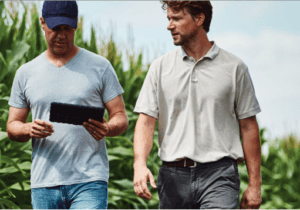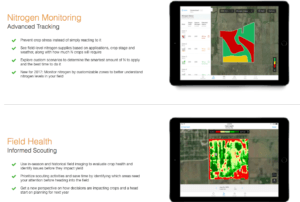Is Big Data and Technology the Solution to the Potential Food Shortage?

Technology, Innovation, Data and Agriculture
“Growing up on a grain and livestock farm in west central Illinois, I have [memories] of my dad sitting at the kitchen table…wondering what might be at play in our fields, what the weather would bring and how it would impact our farm.”[1] As Sam Eathington, now the Chief Scientist of The Climate Corporation, reminisced about growing up on a farm, he described the “powerless feeling to be so dependent on the land and environment…. but having essentially no insight into what’s going on with the plant or below the ground’s surface.” [1] While Sam and his father clearly considered many aspects of the land and environment in an attempt to optimize the harvest, they never could have predicted the impact of climate change and carbon dioxide on their future crop yields.

Although there have been observations over the past 157 years that global temperatures have been rising, there has been an extreme increase in warming over the last 25 years. In fact,“11 of the 12 warmest years on record have occurred in the past 12 years.”[2] In addition to rising temperatures, there have been changes in precipitation patterns and volumes, causing both droughts and floods, as well as an increase in carbon dioxide emissions. All of these factors impact the growing conditions for crops and have caused serious disruption to the agriculture industry, as well as the food industry as a whole. Moreover, the impact of climate change on the agriculture sector causes a serious
threat to food availability, access, quality and price and creates a risky potential for food shortages throughout the world [3]. For instance, U.S. farms supply 25% of all grains on the global market; however, in 2012 severe U.S. droughts “led to record-high prices for grain…increasing the potential for beef, pork, and chicken prices to rise significantly.” [4] The increase in grain causes a chain reaction and impacts more than just the agriculture industry.

Given the rise of climate change as mentioned above, two former Google employees launched Climate Corporation (originally named WeatherBill) to help farmers adapt to climate change through the use of innovative technology and data. The Climate Corporation’s mission is “to build a digitized world where every farmer is able to optimize and flawlessly execute every decision on the farm.” [5] Climate Corporation uses sophisticated data analysis to help farmers identify the impact of recent and current weather conditions so that they can produce more crops while using fewer natural resources, thereby minimizing costs.
While Climate Corporation initially launched in 2006, 8 years later the U.S. Government announced its Climate Change Policies, which were very much aligned with Climate Corporation’s initiatives. The White House Climate Data Initiative, along with the subsequent National Climate Assessment, aimed to address the climate-change effects on the agriculture sector by providing calling upon “America’s private-sector innovators to leverage open government data and other resources to build tools that will make the U.S. and global food systems more resilient against the impacts of climate change.” [6]
Prior to the 2014 Climate Data Initiative, Climate Corporation provided farmers with a paid subscription model with different tiers of service. After the Initiative, Climate Corporation launched a free online and mobile service so all farmers could have access to the company’s data. Moreover, Climate Corporation helped found the Open Ag Data Alliance, which is “an open source software project to ensure farmers have full data access across different agriculture technology platforms.” Climate Corporation is committed to equipping all farmers with the necessary tools and capabilities to leverage their data. [6]

Through the use of data and technology, as well as additional support from the White House, companies like Climate Corporation are trying to increase crop yields and minimize potential food shortages. Although this digital data-centric innovation can be very impactful for the agriculture sector, the technology is only as good as the implementation. Thus, I believe as companies like Climate Corporation continue to innovate, the emphasis has to extend past the technology and include education. Had Sam and his father, as mentioned earlier, had access to such technology would they utilize it or would they stick to their known way of farming and continue to wonder “what the weather or soil might bring to – or rob from – fall harvest?” [1]
Sources:
[1] Sam Eathington, “Sensors and Connecting the Field”, http://www.climateinsights.com/?randomId=wOaAcQpLqqcEg&_ga=1.130135692.2019848151478116412
[2] Intergovernmental Panel on Climate Change (IPCC), “How are Temperatures on Earth Changing?”, http://www.ipcc.ch/publications_and_data/ar4/wg1/en/faq-3-1.html
[3] US Environmental Protection Agency, “Climate Impacts on Agriculture and Food Supply”, https://www.epa.gov/climate-impacts/climate-impacts-agriculture-and-food-supply
[4] UNEP, Geo-5 For Business: Impacts of a Changing Environment on the Corporate Sector, http://web.unep.org/geo/sites/unep.org.geo/files/documents/geo5_for_business.pdf
[5] Climate Corporation, Mission Statement, https://climate.com/company/
[6] The White House, Press Release, “Empowering America’s Agricultural Sector and Strengthening Food Resilience through the President’s Data Climate Initiative”, https://www.whitehouse.gov/the-press-office/2014/07/29/fact-sheet-empowering-america-s-agricultural-sector-and-strengthening-fo



I think agriculture is a great area for start ups like the one in that text. Personally I’ve heard of a great number of startups trying to solve that problem with either drones or private satellites. But collecting data is only one part of the equation. There is a great potential in analyzing that data, predicting the future climate change and suggesting the solutions to solve probably one of these most significant problems of the future.
Great post! As you observed, innovation occurring at the intersection of big data and agriculture could yield enormous benefits, including a reduced risk of food shortages as well as a more efficient and rationalized cost structure up and down the supply chain. Illustrating the bullwhip phenomenon we discussed during our analysis of supply chains, grain shortages in the U.S. will lead to magnified implications further down the chain, resulting in more expensive meat and dairy costs ultimately borne by the consumer. From a cost savings and resource optimization perspective, it behooves all parties in the supply chain to invest in the technology and learning offered by the Climate Corporation and other similar organizations. That being said, I do wonder about the social implications and barriers, as you alluded to in your last sentence. Given the fragmented nature of the agriculture industry, I fear we may see more shortages and negative effects before we see a widespread shift in practice.